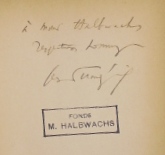Maurice Halbwachs facts for kids
Quick facts for kids
Maurice Halbwachs
|
|
|---|---|
 |
|
| Born | 11 March 1877 Reims, France
|
| Died | 16 March 1945 (aged 68) Buchenwald concentration camp, Nazi Germany
|
| Region | Western Europe |
| School | Structuralism |
|
Main interests
|
Sociology, Philosophy, Anthropology, Cultural Studies, Psychology |
|
Notable ideas
|
Collective memory |
|
Influences
|
|
|
Influenced
|
|
Maurice Halbwachs (French: [mɔˈʁis ˈalbvaks]; born March 11, 1877 – died March 16, 1945) was an important French philosopher and sociologist. He is best known for creating the idea of "collective memory". This is about how groups of people remember things together. Halbwachs also studied how places are remembered in the New Testament.
Early Life and Learning

Maurice Halbwachs was born in Reims, France. He went to a special school in Paris called the École Normale Supérieure. There, he studied philosophy with Henri Bergson. Bergson greatly influenced Halbwachs' early ideas about memory. At first, Halbwachs thought memory was a very personal thing.
After his studies, he became a qualified philosophy teacher in 1901. He taught at different schools. In 1904, he went to Germany. He studied at the University of Göttingen. He also helped organize the papers of a famous thinker named Gottfried Wilhelm Leibniz.
In 1905, Halbwachs returned to France. He met Émile Durkheim, who was a very important sociologist. Durkheim made Halbwachs interested in sociology. Halbwachs started to focus on studying things scientifically. He joined the team that published a sociology journal called L'Année Sociologique. In 1909, he went back to Germany to study Marxism and economics.
Maurice Halbwachs also had a son named Pierre Halbwachs. Pierre later influenced some ideas in philosophy.
Teaching and Work
During World War I, Halbwachs worked for the War Ministry. After the war, in 1919, he became a professor. He taught sociology and pedagogy (the study of teaching) at the University of Strasbourg. He stayed there for over ten years.
In 1930, he was a visiting professor at the University of Chicago for a year. Then, in 1935, he was asked to teach at the Sorbonne in Paris. There, he worked closely with Marcel Mauss. He also became the editor of a new sociology journal.
From 1935 until he died, he taught sociology at the Sorbonne. From 1943, he also taught social psychology at the Collège de France. In 1944, he received a very high honor in France. He was given a special teaching position at the Collège de France in Social Psychology. During this time, Halbwachs did deep research where sociology and psychology meet.
His Death
Maurice Halbwachs was a socialist for a long time. In July 1944, he was arrested in Paris. This happened after he protested the arrest of his Jewish father-in-law. He was sent to a camp called Buchenwald concentration camp. He died there in February 1945 from an illness. His wife's parents were also killed by the Germans.
Some of his books were given by his wife to a library. They are now kept at the Human and Social Sciences Library Paris Descartes-CNRS.
Towards the end of his life, Halbwachs was recognized for his important work. He was chosen to be part of a respected group called the Academie des Sciences Morales et Politiques. He was also the Vice President of the French Psychological Society.
In 1950, his daughter published his most famous work about collective memory. This was after his death.
Main Ideas
Halbwachs' most important idea is found in his book La Mémoire collective (published in 1950). This book is about "The Collective Memory." He believed that a group of people can have a shared memory. This memory depends on the "framework" or setting of the group.
So, there is not only a personal memory but also a group memory. This group memory exists outside of each person. It lives on even after individuals are gone. How a person understands the past is strongly linked to this group memory. This is because each person adds their own memories to the group's shared memory.
Every group has its own collective memory. This memory is different from the memories of other groups. This idea shows how people remember things together in our culture. Remembering events together helps connect people to society. Physical monuments and traditions help make this shared memory stronger.
Halbwachs also wrote about how memory and history are different. He thought that memory can change based on who is remembering. This makes it less reliable for studying the past. But historians try to study history in a very fair way, looking at it from a distance.
Halbwachs also helped social psychology. He wrote about how working-class families managed their money. He found that families plan their budgets not just for now, but also for the future. This makes them think about what is truly needed.
Published Works
- Halbwachs, Maurice, On collective memory, Chicago, The University of Chicago Press, 1992
- Halbwachs, Maurice, The collective memory, New York, Harper & Row Colophon Books, 1980
- You can find parts of this book online.
- Halbwachs, Maurice, La topographie légendaire des évangiles en Terre sainte, 1941
- Halbwachs, Maurice, The Psychology of Social Class, London, Forgotten Books, 2017
See also
 In Spanish: Maurice Halbwachs para niños
In Spanish: Maurice Halbwachs para niños

